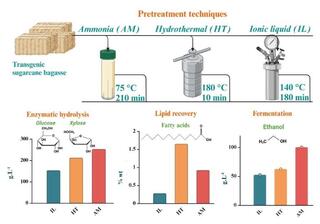Evaluating the Industrial Potential of Emerging Biomass Pretreatment Technologies in Bioethanol Production

Background/Objective
Selecting an appropriate pretreatment method to process lignocellulosic biomass is essential for maximizing product yields. Hydrothermal (HT), soaking in aqueous ammonia (AM), and ionic liquid (IL) pretreatment methods all effectively minimize sugar decomposition, hydrolyze structural carbohydrates, and produce a fermentable hydrolysate used for industrial ethanol production. We compared these three pretreatments for lipid recovery, sugar yield, and ethanol yield using a non-modified sugarcane cultivar (CP88-1762) and two transgenic lipid-accumulating sugarcane lines (oilcane lines 1565 and 1566).
Approach
Bagasse from each feedstock underwent compositional analysis and was subjected to each of the three pretreatment methods. The pretreated biomass underwent high-solids enzymatic hydrolysis using a fed-batch approach to evaluate sugar and phenolic content. The resulting hydrolysates were then fermented using an engineered Saccharomyces cerevisiae strain to assess ethanol production.
Results
The highest sugar yields were obtained from the AM-pretreated hydrolysate (254 g/L), followed by HT-(213 g/L) and IL-pretreated hydrolysates (154 g/L), which produced industrial bioethanol titers of 101 g/L, 64 g/L, and 53 g/L, respectively. AM pretreatment showed the highest productivity (2 g/L/hr). Lower acetic acid in AM-pretreated hydrolysate likely improved fermentability, and reduced sugar and ethanol yields from IL pretreatment were due to Choliniumlysinateinhibition. Oilcane bagassesfrom 1565 and 1566 contained 16-and 3-fold more lipids than CP88-1762, respectively, with lower fatty acid levels observed after AM and IL pretreatments compared to HT.
Significance/Impacts
This research enhances the selection and validation of upstream processing methods for lignocellulosic biomass pipeline processing, which improves economic and environmental outcomes for biorefineries, and shows the first comparison of pretreatment technique viability for oilcane.
Deshavath, N. N., et al., Evaluating the industrial potential of emerging biomass pretreatment technologies in bioethanol production and lipid recovery from transgenic sugarcane. Sustainable Energy & Fuels. (2025). [DOI:10.1039/D5SE00519A]